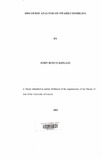| dc.description.abstract | This study is concerned with the language employed in Catholic homilies in Nairobi. It focuses on cohesion, performative quality and pragmatic meaning in selected texts of Swahili homilies. We use an eclectic approach in the study; This approach makes use of cohesion approach by Halliday and Hasan (1976), speech act theory by Austin and Searle and the implicate approach by Grice (1975).
The thesis is organized into six chapters. The first chapter is the introduction. The introductory elements of this study: introduction, statement of the problem, aims and objectives, hypotheses, rationale of the study, scope, literature review and methodology have been dealt with.
The second chapter deals with openings and closings. We look at the different types of openings and closings that are found in homilies. We look at the cohesive concepts that they exhibit, the implicatures they make use of and the performative force that they possess. We analyze the roles that they play in homily discourse.
The third chapter deals with cohesion. It uses the theory as propounded by Halliday and Hasan. We look at reference, lexical relations, substitution, ellipsis, repetition and conjunction cohesion. It is an attempt to show if cohesive devices are salient in homilies. We also look at the cohesive devices, which are preferred in homilies.
Speech act by Austin and Searle and implicature by Grice are handled
in the fourth chapter. Questions and commands are analyzed in the chapter. The preachers and the congregations share common background. We look into the Gricean maxims that preachers flout in order to capture persuasion and interpretation in discourse.
Chapter five concentrates on the language of homilies. Under the types of language preferred, instrumental and powerful language are analyzed.
Clarity through the use of simple sentence structure and diction is looked into. The chapter also focuses on style in homilies. Here we look at the metaphor and lastly on concepts of rhetoric used in homilies.
The last chapter is a conclusion; a summary of the thesis and suggestions for further research | en |

